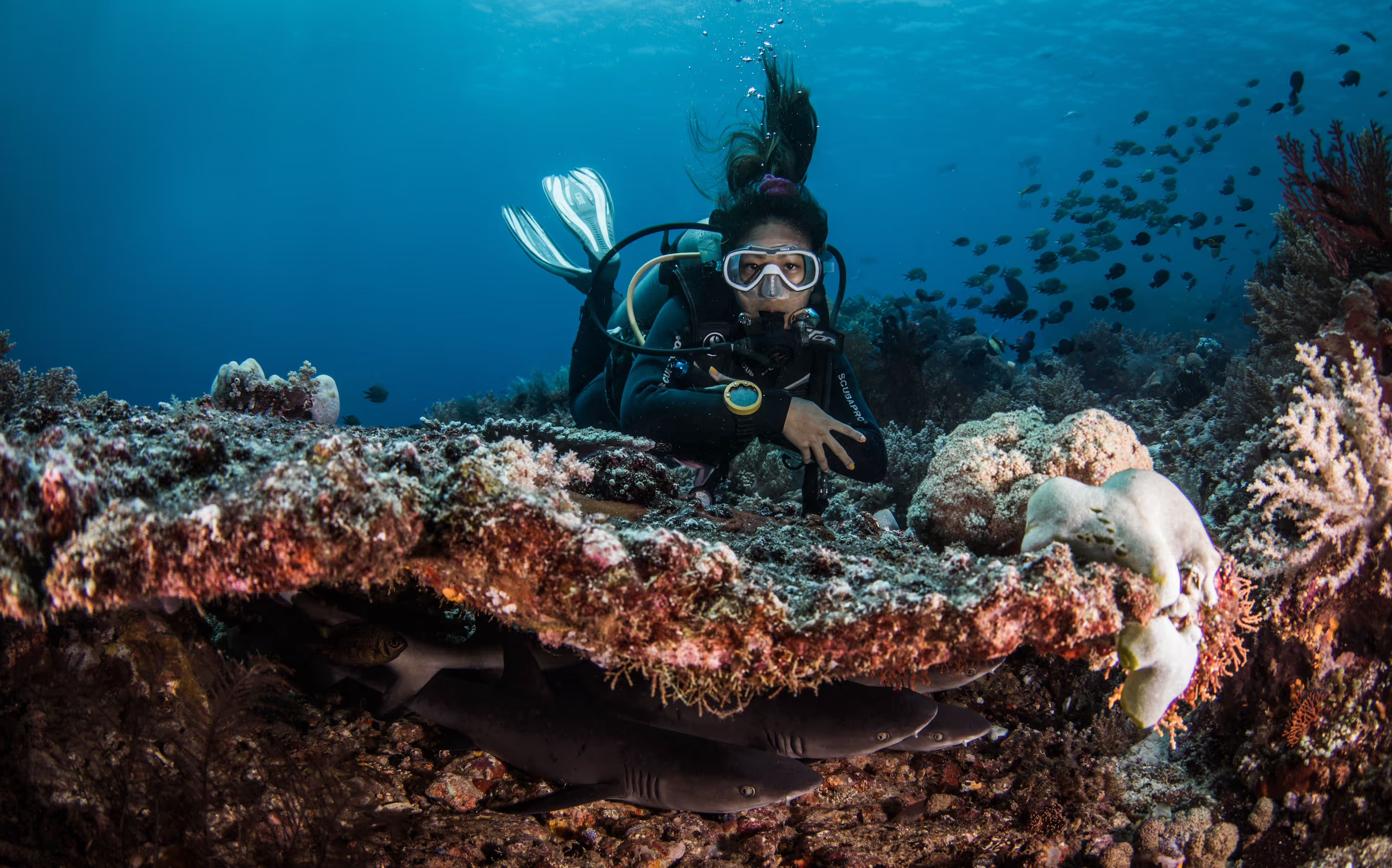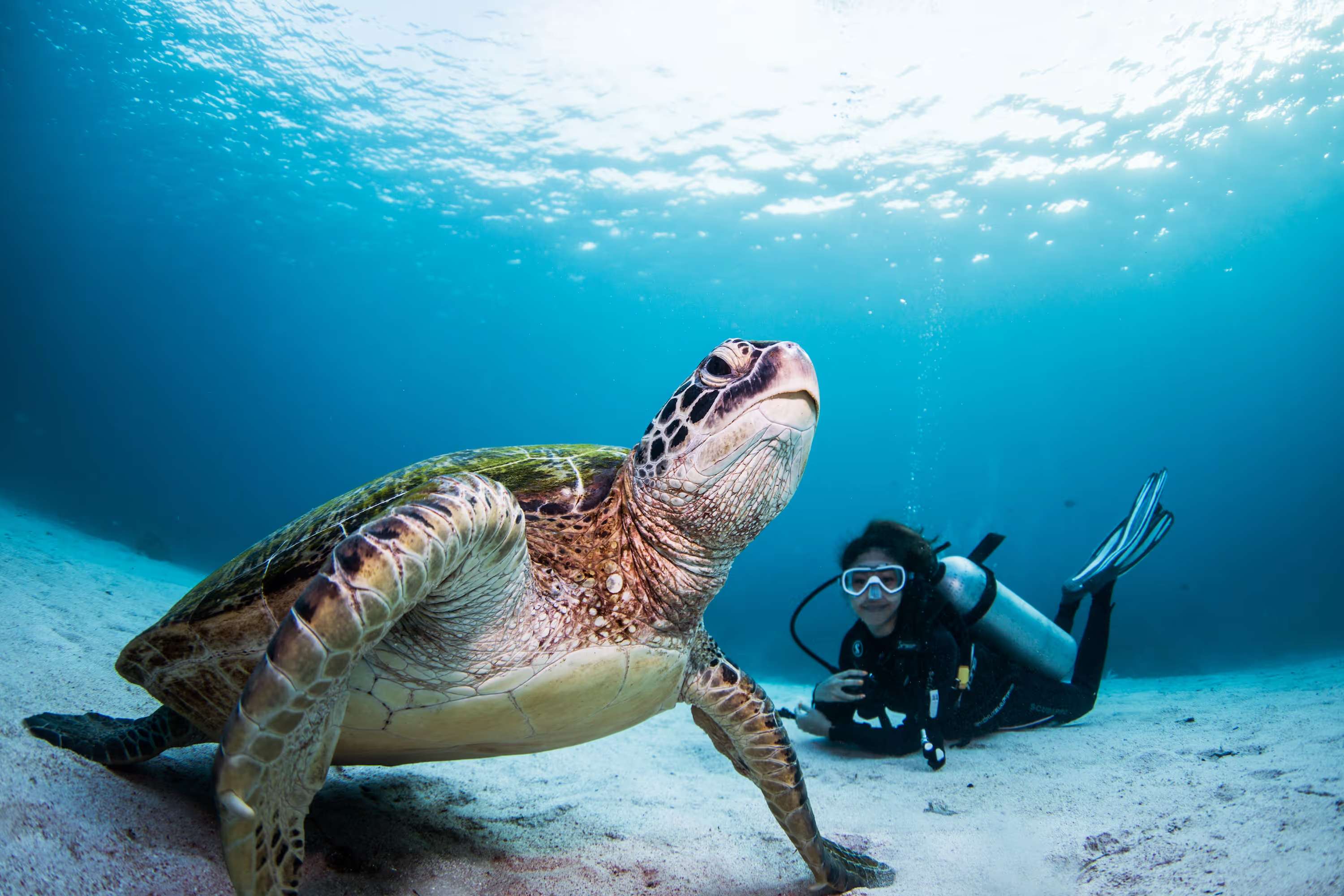Dive Sites at Komodo National Park
The dive sites around Komodo are characterized by the complex and fast currents unique to Komodo, created by the intricate terrain consisting of islands surrounded by the Flores Sea from the north, with warm and highly transparent water, and nutrient-rich deep water from the Indian Ocean in the south. This environment gives rise to an unparalleled abundance of marine life, making Komodo home to a rich and diverse underwater ecosystem unlike any other.
Komodo National Park, located in Indonesia, is a world-renowned dive destination celebrated for its stunning marine biodiversity, vibrant coral reefs, and unique underwater landscapes.

Here are some of the top dive sites within the park:
Batu Bolong
Description: A small rock pinnacle that rises from deep waters, Batu Bolong is famous for its dramatic drop-offs and vibrant coral gardens.
Marine Life: Schools of colorful reef fish, Napoleon wrasse, giant trevally, and occasional sightings of pelagic species like sharks and manta rays.
Highlights: The site offers strong currents that bring nutrient-rich waters, supporting a thriving ecosystem.
Batu Bolong is an approximately 80-meter rocky outcrop located between Komodo and Tatawa Islands. The top of the rock is visible from the surface, and depending on the angle, you can observe holes in the rock formations. Divers typically descend from the opposite side of the reef where the current flows and zigzag along both sides of the current, but when the current is weak, it’s also possible to circumnavigate the reef. The density of marine life here is unparalleled among Komodo’s dive sites, giving divers a feeling akin to being in an aquarium. You can observe fish of various sizes, and occasionally spot dolphins.
More informationCastle Rock
Description: An underwater seamount located north of Komodo Island.
Marine Life: Known for its dense schools of fusiliers, trevallies, and barracudas. Divers often encounter grey reef sharks and whitetip reef sharks.
Highlights: The currents here attract large pelagics, making it a hotspot for action-packed dives.
Castle Rock is one of the iconic dive sites representing Komodo, located north of Gili Lawa Laut, itself situated to the north of Komodo Island. The top of the rock lies approximately 5 meters below the surface and is densely covered with coral. This site often experiences strong currents, requiring swift descents, but these currents attract sightings of large pelagic fish such as whitetip reef sharks, grey reef sharks, giant trevallies, and Napoleon wrasses.
Crystal Rock
Description: Another pinnacle dive site near Castle Rock, characterized by clear waters and a rich marine life.
Marine Life: Reef sharks, manta rays, and diverse coral species. Schools of anthias and other reef fish are abundant.
Highlights: Excellent visibility and a chance to see a wide range of species in one dive.
Manta Point (Makassar Reef)
Description: A long, shallow drift dive site known for frequent manta ray sightings.
Marine Life: Manta rays are the main attraction, often seen feeding or being cleaned at the cleaning stations. Other sightings include eagle rays, turtles, and various reef fish.
Highlights: The opportunity to observe manta rays up close in their natural habitat.
Located east of Komodo Island, this site features scattered manta cleaning stations on the reef. If you're lucky, you can spot mantas from the boat or while snorkeling. When the currents are strong, you can use a current hook around the cleaning stations to leisurely enjoy watching the mantas. Sometimes, you can witness scenes where more than 10 mantas are queuing up. Additionally, sightings of black mantas, whitetip reef sharks, trevallies, green sea turtles, eagle rays, and schools of unicornfish are also possible.
More informationThe Couldron (Shotgun)
Description: A unique dive site with a natural channel and a bowl-shaped area that creates a thrilling drift dive experience.
Marine Life: Schools of trevallies, sharks, and sometimes manta rays. The currents here bring a high concentration of plankton, attracting diverse marine life.
Highlights: The sensation of being "shot" through the channel by the current, hence the nickname "Shotgun."
This is a site that passes through a strait between two islands, Gili Lawadarat and Gili Lawalaut, mainly drifting from north to south during falling tide. Along the way, there is a large fish bowl at a depth of about 23 meters, and after passing through there, the shotgun begins around the area where the depth increases. Flow with the current while being swept along. Besides Manta Point, you can often observe mantas here as well.
Siaba Besar
Description: A sheltered bay ideal for less experienced divers and macro enthusiasts.
Marine Life: Seahorses, pipefish, frogfish, and a variety of small critters. It's also a good spot for finding turtles grazing on the seagrass beds
Highlights: Calm conditions and rich macro life make it perfect for leisurely dives and photography.
More informationYellow Wall of Texas
Description: A vibrant wall dive located at the southern end of Rinca Island.
Marine Life: Known for its yellow and orange soft corals, which attract various reef fish, nudibranchs, and critters.
Highlights: The colorful coral walls and the abundance of macro life make it a paradise for underwater photographers.
Siaba Kecil
Description: Known for its strong currents, Siaba Kecil offers an exhilarating drift dive over lush coral gardens and steep slopes.
Marine Life: Green sea turtles, reef fish, nudibranchs, and sometimes reef sharks and manta rays.
Highlights: drift Diving. Ideal for intermediate to advanced divers.
This is a small island opposite Siaba Besar where during falling tide, experienced divers can drift from north to south along the eastern side of the island, following the contour of the island while keeping the sloping reef on their right. There are sections along the way where the reef overhangs, and if the current is weak, you can venture a bit inside. The other way around during raising tide, divers can drift from south to north. It's a relatively advanced spot. Many sightings of dugongs have been reported on the southern side of the island, making it a recently popular site.
Tatawa Besar
Description: Known for its beautiful coral gardens and gentle drift diving conditions.
Marine Life: Abundant reef fish, occasional turtles, and various pelagics in the deeper sections.
Highlights: The diverse coral formations and the ease of diving due to milder currents.
Pink Beach (Pantai Merah)
Description: A famous beach with pink sand, offering easy shore dives.
Marine Life: Rich coral gardens with a variety of small fish, nudibranchs, and sometimes larger pelagics in the deeper areas.
Highlights: The unique pink sand and vibrant underwater scenery close to the shore.
Nusa Kode
Description: A remote site on the southern side of Rinca Island, offering dramatic underwater topography.
Marine Life: Large pelagics, diverse reef species, and occasionally mola mola (sunfish).
Highlights: The rugged landscapes and the chance to see less commonly encountered species.
Each of these dive sites in Komodo National Park offers a unique experience, from thrilling drift dives and encounters with large pelagics to vibrant coral gardens and macro life, making the park a must-visit destination for divers of all levels.


